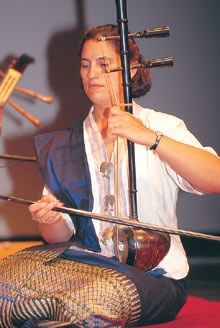| Some facts about the music of your country: |

|
 |
Links: |
Korea: Traditional music in Korea centers on the voice. The voice is seen as distinctive to the Korean people and their culture. Improvisation is common in Korean music as well as a lack of breaks between the various sections in a piece of music. A “pansori”performance in Korea can last up to 8 hours with a single vocalist singing continually. Korean pieces of music start slower and increase in tempo. The music of the upper class is called Jeongak. It is slow, soft and tranquil and has an intellectual basis. In Western music, the beat is based on the heartbeat, but in this style of music, it is based on breath, which is much slower. Minsogak is the traditional folk music of the common person. It’s beat is closer to that of a heartbeat. It is also more expressive and emotional than Jeongak. Some Korean instruments include; Piri: A cylindrical oboe Gayageum: a 12 stinged zither Jing: a hanging gong Eo: a scraper shaped like a tiger Danso: end-blown flute Thailand: Music in Thailand is often an expression of the many cultures that surround it, like Cambodia, China, Laos and Malaysia. To define music that is more precisely Thai, would be to look at the classical music from the courts of Central Thailand. A very traditional ensemble from this area is called the piphat and dates back to the 13th century. These ensembles, made up of fiddles, woodwind style instruments, gongs, xylophones and cymbals are still used throughout the country. This is similar to the gamelan ensembles of Indonesia and is an example of how Thailand is connected culturally to other Southeast Asia countries. The Thai people also listen to contemporary music that was influences by western rock, rap and jazz. There is also a form of Thai country music called ‘luk thung’ meaning “child on the field”. It is popular with the countries poorer people. Some instruments from Thailand include: Ranart-toom: Thai Xylophone Kim: Zither Ton-Ramana: Hand Drum Gongs of various sizes. Saw-U: Thai Violin China: In China, music is traditionally used not for entertainment or amusement but for the much higher purpose of purifying ones thoughts. It is believed to calm one’s passions and unrest. Melody and tone, and their articulation are much more important that rhythm/beat in Chinese music. Historically, this country’s music can be traced back over 7000 years. As music developed, it was often used in religious events and various types of Opera. Opera has become a very significant part of Chinese culture. The style referred to as the Beijing opera is very popular, however Chinese peasants have also created their own independent folk songs that reflect their daily lives. Some Chinese instruments include: Erhu: A two stringed instrument with an intertwined bow. Pipa: a flute named for the loquat fruit. Guzheng: A horizontal stringed instrument similar to a zither. Russia: During the 1800’s, Russia began to develop a unique style of nationalistic music that had it’s roots in both folk music and the music of the Russian church. Until this time, the classical music in Russia was dominated by the likes of Beethoven, Mozart, Haydn and other europeans. Then around 1830, Russian composers began writing pieces that had local folk tunes as their basis. These composers included Stravinsky, Rachmaninoff and Glinka. This music was characterized by the repetitive use of short tunes from the folk songs and a dance-like rhythm. Some traditional Russian instruments: Svirel: Wooden end blown flute Gusli: 7 stringed zither Balalaika: triangular shaped folk guitar |